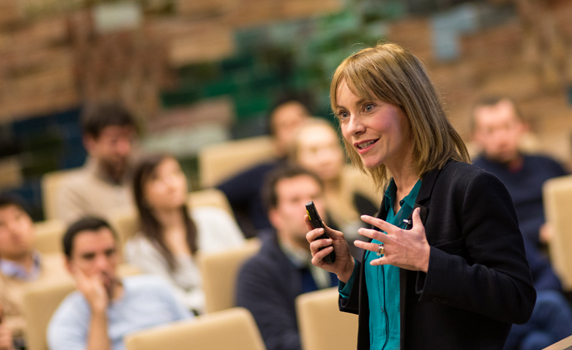
In 1975, Bill Gates dared to envision a computer in every household. Forty years later, vision accomplished and surpassed, the average European family has 10 web-based devices per household. And thus, explained María Garaña, President of Microsoft Spain, today the founder's successors at Microsoft are driving a corporate transformation for digital lifestyles unimaginable four decades ago.
While Microsoft pioneered technology for the day-to-day now it is, "breaking down barriers between consumer and corporate spaces so that end users can move naturally between both worlds," explained Garaña during her presentation at this week's Global Leadership Series with MBA students. A shift in its traditional software-based business model to one focused on offering clients new experiences through devices and services at home and at work is facilitating this seamless digital integration across the range of new technologies.
“Microsoft not only has something to say in the four conversations that are defining the digital transformation - cloud, social, big data and mobile - but it is also positioning itself to steer the conversation,” explained Garaña. And businesses are listening on all four fronts. For example, in Spain alone Microsoft is taking 250 companies to the cloud every week. “That includes large household names, but also SMEs,” she told the audience. With the advantages of cost and flexibility, the cloud offers consumers new opportunities. For instance, Ms. Garaña cited the case of Telecinco, which thanks to Microsoft, was able to obtain the huge infrastructure necessary for the retransmission of the Football World Cup on the Internet, but for only four weeks.
In social, the company is helping clients integrate the three often-separate spheres − web presence, online ads and social networks −into the same execution plan. In this case, through Yammer, Skydrive, Lync2013 and Office 365, Microsoft can help a large company such as Telefónica to foster the same corporate culture for its 130,000 employees world-wide. On the big data front, Microsoft services allows organizations both large and small to move from information to action, while, “with devices now at the center of mobility, we are focusing on developing more natural user interfaces such as voice and hands to easily adapt them into our daily routine.”
No matter the type of technology a client is considering, it no longer delegates such decisions solely to IT. “When businesses are deciding on a platform, it is not just about technology, but a critical business decision that will have an impact on a company culture and employees,” Garaña pointed out.
When asked how far she envisioned technology − especially devices − penetrating daily life, Ms. Garaña responded, “Anything with a chip inside is a device, whether in a home appliance or a computer. And there is much yet to explore, such as Kinect technology’s potential in the medical field. Certainly there are challenges to work out, for example in terms of security, but otherwise, the sky is the limit.”